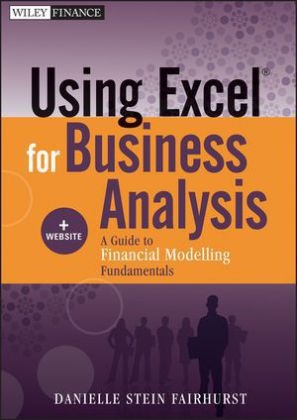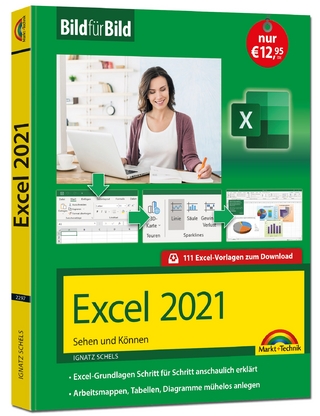
Using Excel for Business Analysis
John Wiley & Sons Inc (Verlag)
978-1-118-13284-5 (ISBN)
- Titel ist leider vergriffen;
keine Neuauflage - Artikel merken
A clear, concise, and easy-to-use guide to financial modelling suitable for practitioners at every level Using a fundamental approach to financial modelling that's accessible to both new and experienced professionals, Using Excel for Business Analysis: A Guide to Financial Modelling Fundamentals + Website offers practical guidance for anyone looking to build financial models for business proposals, to evaluate opportunities, or to craft financial reports. Comprehensive in nature, the book covers the principles and best practices of financial modelling, including the Excel tools, formulas, and functions to master, and the techniques and strategies necessary to eliminate errors. As well as explaining the essentials of financial modelling, Using Excel for Business Analysis is packed with exercises and case studies to help you practice and test your comprehension, and includes additional resources online.
* Provides comprehensive coverage of the principles and best practices of financial modeling, including planning, how to structure a model, layout, the anatomy of a good model, rebuilding an inherited model, and much more * Demonstrates the technical Excel tools and techniques needed to build a good model successfully * Outlines the skills you need to learn in order to be a good financial modeller, such as technical, design, and business and industry knowledge * Illustrates successful best practice modeling techniques such as linking, formula consistency, formatting, and labeling * Describes strategies for reducing errors and how to build error checks and other methods to ensure accurate and robust models A practical guide for professionals, including those who do not come from a financial background, Using Excel for Business Analysis is a fundamentals-rich approach to financial modeling.
DANIELLE STEIN FAIRHURST is the Principal of Plum Solutions, a Sydney-based consultancy specialising in financial modelling and analysis. With many years' experience as a financial analyst, she helps her clients create meaningful financial models. She has hands-on experience in a number of industry sectors, including telecommunications, information systems, manufacturing, and financial services. Stein Fairhurst is regularly engaged as a speaker, course facilitator, financial modelling consultant, and analyst around the world, and has taught management accounting subjects at Sydney University.
Preface xi CHAPTER 1 What Is Financial Modelling? 1 What s the Difference between a Spreadsheet and a Financial Model? 3 Types and Purposes of Financial Models 4 Tool Selection 5 What Skills Do You Need to Be a Good Financial Modeller? 10 The Ideal Financial Modeller 16 Summary 19 CHAPTER 2 Building a Model 21 Model Design 21 The Golden Rules for Model Design 22 Design Issues 24 The Workbook Anatomy of a Model 25 Project Planning Your Model 27 Model Layout Flow Charting 28 Steps to Building a Model 28 Information Requests 35 Version-Control Documentation 36 Summary 37 CHAPTER 3 Best Practice Principles of Modelling 39 Document Your Assumptions 39 Linking, Not Hard Coding 39 Only Enter Data Once 40 Avoid Bad Habits 41 Use Consistent Formulas 41 Format and Label Clearly 41 Methods and Tools of Assumptions Documentation 42 Linked Dynamic Text Assumptions Documentation 48 What Makes a Good Model? 51 Summary 52 CHAPTER 4 Financial Modelling Techniques 53 The Problem with Excel 53 Error Avoidance Strategies 54 How Long Should a Formula Be? 59 Linking to External Files 61 Building Error Checks 63 Avoid Error Displays in Formulas 66 Circular References 67 Summary 70 CHAPTER 5 Using Excel in Financial Modelling 71 Formulas and Functions in Excel 71 Excel Versions 73 Handy Excel Shortcuts 74 Basic Excel Functions 76 Logical Functions 82 Nesting: Combining Simple Functions to Create Complex Formulas 84 Cell Referencing Best Practices 86 Named Ranges 89 Summary 92 CHAPTER 6 Functions for Financial Modelling 93 Aggregation Functions 93 LOOKUP Formulas 100 Other Useful Functions 106 Working with Dates 115 Financial Project Evaluation Functions 121 Loan Calculations 126 Summary 131 CHAPTER 7 Tools for Model Display 133 Basic Formatting 133 Custom Formatting 133 Conditional Formatting 139 Sparklines 143 Bulletproofing Your Model 147 Customising the Display Settings 151 Form Controls 157 Summary 171 CHAPTER 8 Tools for Financial Modelling 173 Hiding Sections of a Model 173 Grouping 178 Array Formulas 179 Goal Seeking 184 Pivot Tables 186 Macros 190 User-Defined Functions (UDFs) 198 Summary 200 CHAPTER 9 Common Uses of Tools in Financial Modelling 201 Escalation Methods for Modelling 201 Understanding Nominal and Effective (Real) Rates 206 Calculating Cumulative Totals 209 How to Calculate a Payback Period 210 Weighted Average Cost of Capital (WACC) 214 Building a Tiering Table 216 Modelling Depreciation Methods 219 Break-Even Analysis 227 Summary 233 CHAPTER 10 Model Review 235 Rebuilding an Inherited Model 235 Auditing a Financial Model 245 Appendix 10.1: QA Log 250 Summary 250 CHAPTER 11 Stress-Testing, Scenarios, and Sensitivity Analysis in Financial Modelling 251 What s the Difference between Scenario, Sensitivity, and What-If Analysis? 252 Overview of Scenario Analysis Tools and Methods 253 Advanced Conditional Formatting 261 Comparing Scenario Methods 264 Summary 273 CHAPTER 12 Presenting Model Output 275 Preparing an Oral Presentation for Model Results 275 Preparing a Graphic or Written Presentation for Model Results 276 Chart Types 279 Working with Charts 291 Handy Charting Hints 295 Dynamic Range Names 297 Charting with Two Different Axes and Chart Types 300 Bubble Charts 302 Waterfall Charts 307 Summary 316 About the Author 317 About the Website 319 Index 321
| Zusatzinfo | Illustrations |
|---|---|
| Verlagsort | New York |
| Sprache | englisch |
| Maße | 182 x 254 mm |
| Gewicht | 654 g |
| Einbandart | Paperback |
| Themenwelt | Informatik ► Office Programme ► Excel |
| Wirtschaft ► Betriebswirtschaft / Management ► Finanzierung | |
| ISBN-10 | 1-118-13284-X / 111813284X |
| ISBN-13 | 978-1-118-13284-5 / 9781118132845 |
| Zustand | Neuware |
| Informationen gemäß Produktsicherheitsverordnung (GPSR) | |
| Haben Sie eine Frage zum Produkt? |
aus dem Bereich


